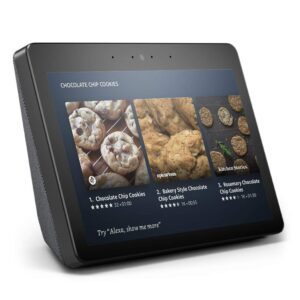In 2024, the U.S. Federal Trade Commission received over 1.1 million identity theft reports, resulting in losses exceeding $12.7 billion (source). It’s easy to think identity theft won’t happen to you—until it does. One hacked email account can expose family photos, bank information, and even your kids’ schoolwork. As part of Cybersecurity Awareness Month, we’re sharing simple habits to protect your family’s digital life—no technology expertise required.
Disclosure: This blog may contain affiliate links, which means we may earn a commission if you click a link and make a purchase (at no additional cost). We only recommend products and services we use and trust. We aim to provide valuable, trustworthy resources that enhance and simplify your life. You can read our full privacy policy here.
Family Cybersecurity is More At-Risk Than Ever
According to Statista, in 2023, more than 353 million individuals in the U.S. were impacted by data compromise incidents, including breaches, leaks, or exposures (source). Unfortunately, families are more vulnerable to cybersecurity breaches. Using shared passwords, being logged into multiple devices, and varying degrees of technological literacy within the family are all contributing factors. Unfortunately, caregivers managing the digital lives of aging parents often face double exposure.
🎯Straightforward tips to safeguard your financial and personal information – Fraud Prevention: How to Protect Yourself from Dangerous Scams

Cybersecurity Foundation: Strong Password Habits Everyone Needs
Weak Passwords Put Your Whole Family at Risk
Data leaks from April 2024 through early 2025 exposed more than 19 billion passwords. Hackers found that users reused or duplicated 94% of the exposed passwords across multiple accounts. (source).
Common password mistakes include:
- Reusing passwords
- Passwords with simple patterns or common words
- Sharing passwords through text or email
💻These 29 tips are a great place to start to protect yourself online – 29 Ways to Protect Yourself During Cybersecurity Awareness Month
Creating a Family Password Strategy
Thankfully, password managers, such as LastPass and Proton Pass, are a simple way to protect your passwords and avoid common password mistakes. Password managers generate strong, unique passwords for every account, eliminating the need to memorize them. Additionally, they offer secure password sharing and send you alerts for data breaches. Essentially, password managers make digital life simpler, less stressful, and more secure. The best part is that a password manager like Proton Pass is user-friendly and is the perfect solution for non-tech-savvy families.
👉🏻 It’s a sad fact that seniors are particularly vulnerable to scammers and fraud – 10 Ways to Protect Seniors From Fraud

Protecting Important Documents for Family Cybersecurity
Many families maintain digital files of their most important documents, including medical records, tax returns, bank statements, Social Security cards, and even birth certificates. It’s convenient to keep digital copies of these documents, but they are vulnerable to hackers, accidental loss, or phishing scams. Unfortunately, one weak password can suddenly expose your family’s sensitive information.
Secure digital vaults are apps or services that specifically protect essential files. Encryption, strong passwords, and sometimes multi-factor authentication protect sensitive information, including financial records, medical data, legal documents, and insurance policies. Unlike storing documents in email or on a basic desktop, these vaults act as a digital safe. Therefore, only those with the proper credentials can access the contents. Families using secure digital vaults have secure shared access and ongoing protection from breaches.
✅ Digital disorganization doesn’t just waste time—it creates unnecessary tension, drains mental energy, and leaves families feeling perpetually behind – Why Digital Organization Matters and How to Get Started

Simple Family Cybersecurity Practices
There are some practical steps to take to increase your family’s cybersecurity:
- Enable Two-factor authentication (2FA): Adds an extra layer of security to your online accounts beyond just a password, as it requires a second verification step, such as a text code sent to your phone, an authenticator app, or a physical security key.
- Recognize phishing attempts: Most phishing schemes have common red flags, such as urgent or alarming messages, suspicious sender addresses, requests for personal information, or unexpected attachments or links. Recognizing and reporting these scams will go a long way in enhancing your family’s cybersecurity.
- Safe browsing habits: When you are on the internet, be sure to verify URLs, avoid suspicious links, and double-check sources before trusting information or giving any personal information.
- Use secure Wi-Fi practices at home: Make sure your Wi-Fi password is strong and unique, enable WPA3 or WPA2 encryption, change the network name (SSID) to avoid using personal information such as your family name or address, and regularly update your router’s software to patch security vulnerabilities.
- Help older family members spot digital threats: Older adults are especially vulnerable to online scams. Educate your loved ones with these tips to spot digital threats online.
🏠 With integrated tech solutions, your family can enjoy security, simplify daily digital interactions, and maintain better control over your online presence – 6 Must-Have Tech Tools for Family Security Online
Your Family’s Cybersecurity Step-by-Step Action Plan
Fortunately, protecting your family’s cybersecurity can be simple and quick. First, audit your current password practices and choose a password manager. Next, set up a password manager for yourself, then add family members who will be sharing your account. Then, enable two-factor authentication on critical accounts, such as banking, email, and healthcare portals. Finally, organize your essential documents into a secure digital vault. For ongoing maintenance, monthly password checks take just 5-10 minutes and can ensure your ongoing online security.
Join Our Mailing List
Get the latest news and insights from True Assisting delivered straight to your inbox. Click here to✨ subscribe to our newsletter.✨




